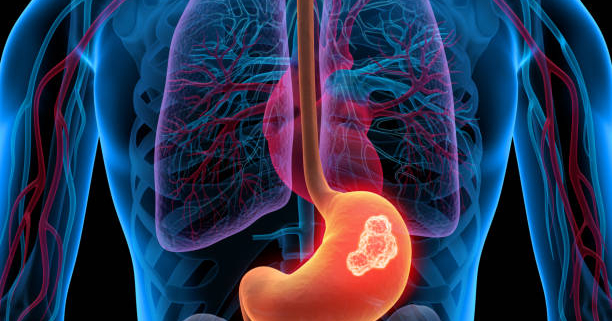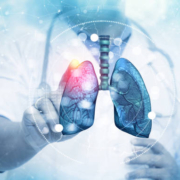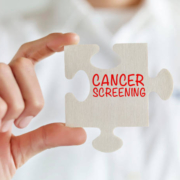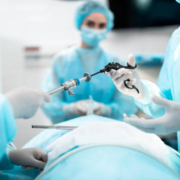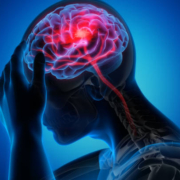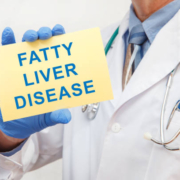Gastric cancer, also known as stomach cancer, is a serious health condition that arises when abnormal cells in the stomach lining multiply uncontrollably, forming a tumor. These malignant cells can spread to other parts of the body through the bloodstream or lymphatic system if left untreated. This article delves into the complexities of gastric cancer, exploring its various types, risk factors, diagnosis methods, and available treatment approaches.
Understanding Gastric Cancer
The inner lining of the stomach is responsible for producing digestive juices that break down food. Gastric cancer disrupts this process by causing the uncontrolled growth of abnormal cells within this lining. The vast majority of stomach cancers (around 90-95%) are adenocarcinomas, originating from the glandular cells that secrete digestive enzymes.
Who Faces a Higher Risk?
Certain factors can increase an individual’s susceptibility to gastric cancer. These include:
- Age: The risk of developing gastric cancer rises significantly with age, particularly for those above 60 years old.
- Family History: Having a close relative with a history of stomach cancer elevates your risk.
- Stomach Conditions: Pre-existing stomach issues like ulcers can contribute to an increased risk.
- Lifestyle Habits: Smoking tobacco and consuming excessive amounts of alcohol are significant risk factors.
- Dietary Choices: Diets high in processed meats, smoked foods, and salted foods, coupled with a lack of fruits and vegetables, can contribute to the development of gastric cancer.
- Helicobacter Pylori (H. pylori) Infection: This bacterial infection can cause chronic inflammation in the stomach lining, potentially leading to cancer in some cases.
It’s important to remember that even individuals without these risk factors can develop gastric cancer. Early detection is crucial for a favorable prognosis.
The Different Faces of Gastric Cancer
Gastric cancer manifests in various forms, each with its own characteristics:
- Adenocarcinomas: As mentioned earlier, these are the most common type of stomach cancer. They can be further classified into two subtypes:
- Intestinal Type: This subtype generally has a better prognosis and may respond well to targeted therapy due to specific genetic traits. It tends to grow slower and stay localized within the stomach for a longer duration before spreading.
- Diffuse Type: This type spreads more aggressively compared to the intestinal type. It’s less common but presents treatment challenges due to its rapid growth and metastasis.
- Gastrointestinal Stromal Tumours (GISTs): These are a less frequent type of sarcoma arising from specific cells located throughout the digestive system. Their behavior can vary, with some exhibiting slow growth and others spreading rapidly to the liver and surrounding tissues.
- Neuroendocrine Tumours: These tumors develop from cells with features of both nerve and hormone-producing cells. While some are slow-growing, others can progress quickly. Diagnosis and treatment depend on the tumor’s grade and stage.
- Lymphomas: These cancers originate from lymphocytes, a type of immune cell. Lymphomas of the stomach, such as diffuse large B-cell lymphoma and MALT lymphoma, require specific treatment approaches like chemotherapy and immunotherapy.
Recognizing the Warning Signs
Early-stage gastric cancer often doesn’t present with noticeable symptoms. However, as the cancer progresses, some potential signs and symptoms may emerge, including:
- Indigestion-like pain: This discomfort can occur in the upper middle abdomen, similar to ulcer pain, due to stomach acid irritating the inflamed cancerous tissue.
- Swallowing difficulties: A sensation of food getting stuck in the throat can indicate a tumor obstructing the passage of food into the stomach.
- Persistent heartburn or acid reflux: A growing tumor can hinder the movement of food through the digestive tract, leading to frequent heartburn.
- Digestive issues: Bloating, nausea, loss of appetite, and feeling full after small meals are common as tumor growth disrupts normal digestion and stomach emptying.
- Unexplained weight loss: This can occur as the body burns extra calories due to cancer inflammation or struggles to absorb nutrients due to the spread of cancer.
- Fatigue and weakness: These symptoms often develop as the body combats the disease and experiences reduced energy intake due to appetite loss.
- Vomiting blood: Blood in vomit, appearing black in color, suggests internal bleeding from the cancerous lesion in the upper gastrointestinal tract.
- Dizziness: Low iron levels caused by chronic blood loss can lead to dizziness.
- Abdominal swelling: Fluid buildup around the stomach due to metastases releasing fluids into surrounding tissues can cause swelling.
- Skin problems: Advanced cases, where cancer cells spread through the bloodstream, can manifest as unusual skin bumps or changes.
Causes of Gastric Cancer and Exploring Treatment Options
While the exact causes of gastric cancer remain under investigation, researchers have identified several contributing factors:
- Dietary Habits: Regularly consuming processed meats, smoked foods, and salted foods can damage the stomach lining over time. Additionally, a diet lacking in antioxidants, found in fruits and vegetables, can also contribute to the risk.
- H. pylori Infection: Chronic infection with this bacterium can cause chronic inflammation in the stomach, potentially leading to cell mutations and cancer development.
- Genetic Predisposition: Having a close family member with gastric cancer increases your risk. Specific gene mutations can also be hereditary factors.
- Anatomical Changes: Prior surgeries like partial stomach removal and conditions like pernicious anemia can elevate the risk.
- Lifestyle Choices: Smoking tobacco, excessive alcohol consumption, obesity, and physical inactivity are modifiable risk factors.
- Occupational Exposures: Prolonged contact with certain substances like coal dust, rubber dust, asbestos, and specific metals may contribute to the risk.
- Radiation Exposure: Prior radiation therapy for other cancers can increase the risk of developing gastric cancer.
- Oncogene Imbalances: Genetic alterations that accelerate cell growth, such as KRAS mutations and HER2 gene amplification, can play a role in tumor progression.
By minimizing controllable risk factors through healthy lifestyle choices and regular screenings, individuals can potentially reduce their chances of developing gastric cancer.
Diagnosing Gastric Cancer: A Multifaceted Approach
Early and accurate diagnosis is crucial for effective treatment of gastric cancer. Physicians typically employ a combination of diagnostic tests, including:
- Endoscopy: A thin, flexible tube with a camera (endoscope) is inserted through the mouth to examine the digestive tract. Tissue samples can be collected during the procedure for further analysis.
- Endoscopic Ultrasound: This specialized technique combines endoscopy with ultrasound technology to provide detailed images of the stomach wall layers, aiding in the detection of deeper tumors.
- Barium Swallow: The patient drinks a liquid containing barium while X-ray images are captured to visualize the throat and stomach for abnormalities.
- CT Scan: This imaging technique uses X-rays and computer technology to generate detailed cross-sectional images of the stomach, aiding in tumor detection and staging. Contrast agents may be administered orally and intravenously to enhance image clarity.
- PET Scan: This test involves injecting a mildly radioactive sugar solution into the bloodstream. Cancer cells are known to take up more sugar than healthy cells. A PET scan can detect these areas of increased sugar uptake, potentially revealing the presence and spread of cancer.
- Laparoscopy: A thin, lighted tube is inserted through a small incision in the abdomen to visually examine the abdominal cavity and nearby organs for signs of metastasis.
- Blood Tests: These tests can help identify anemia and other potential indicators of gastric cancer.
- Stool Test: This test checks for the presence of blood in the stool, which could be a sign of upper gastrointestinal bleeding.
- Biopsy: This definitive diagnostic procedure involves extracting a small tissue sample from the suspicious area. The sample is then examined under a microscope to confirm the presence or absence of cancer cells and determine the cancer type.
Tailoring Treatment to the Individual: A Look at Treatment Options
The chosen treatment approach for gastric cancer depends on various factors such as the type and stage of the cancer, the patient’s overall health, and available treatment options:
- Surgery: This is the primary treatment for most curable gastric cancers. It may involve removing all or part of the stomach (gastrectomy) along with nearby lymph nodes. Laparoscopic techniques can sometimes be employed, offering quicker recovery times.
- Supportive (Palliative) Care: This approach focuses on improving the patient’s quality of life and managing symptoms such as pain, nausea, and fatigue, particularly in advanced or incurable cases.
- Chemotherapy: This treatment utilizes powerful drugs delivered intravenously to destroy cancer cells. It is often used before surgery to shrink the tumor or after surgery to reduce the risk of recurrence.
- Targeted Therapy: For advanced cancers with specific genetic mutations, targeted drugs can be used to attack these specific molecular pathways, potentially offering a more precise approach to treatment.
- Immunotherapy: This relatively new approach involves stimulating the body’s immune system to recognize and fight cancer cells. Immunotherapy has shown promising results in treating gastric cancer, offering hope for future advancements.
- Radiation Therapy: Focused high-energy X-rays are used to kill or shrink tumors. It can be used in combination with other therapies or for palliative purposes to manage pain in advanced stages.
Conclusion
Gastric cancer, though a serious condition, can be effectively managed with early detection and proper treatment. By understanding the different types, risk factors, symptoms, and available treatment options, individuals can empower themselves to empower themselves to make informed decisions about their health. Early detection through regular checkups and awareness of potential symptoms is crucial for a favorable prognosis. Additionally, adopting a healthy lifestyle that incorporates a balanced diet, regular exercise, and maintaining a healthy weight can significantly reduce the risk of developing gastric cancer. While ongoing research continues to unveil more about the complexities of this disease, advancements in diagnosis and treatment offer a brighter outlook for those battling gastric cancer. Remember, knowledge is power, and arming yourself with information is the first step towards taking control of your health.

